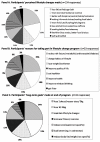Self-management for obesity and cardio-metabolic fitness: description and evaluation of the lifestyle modification program of a randomised controlled trial
- PMID: 18954466
- PMCID: PMC2582031
- DOI: 10.1186/1479-5868-5-53
Self-management for obesity and cardio-metabolic fitness: description and evaluation of the lifestyle modification program of a randomised controlled trial
Abstract
Background: Sustainable lifestyle modification strategies are needed to address obesity and cardiovascular risk factors. Intensive, individualised programs have been successful, but are limited by time and resources. We have formulated a group-based lifestyle education program based upon national diet and physical activity (PA) recommendations to manage obesity and cardio-metabolic risk factors. This article describes the content and delivery of this program, with information on compliance and acceptability.
Methods: Overweight/obese adults (n = 153) with metabolic syndrome were recruited from the community and randomly allocated to intervention (INT) or control (CON). Written copies of Australian national dietary and PA guidelines were provided to all participants. INT took part in a 16-week lifestyle program which provided a curriculum and practical strategies on 1) dietary and PA information based on national guidelines, 2) behavioural self-management tools, 3) food-label reading, supermarkets tour and cooking, 4) exercise sessions, and 5) peer-group support. Compliance was assessed using attendance records and weekly food/PA logs. Participants' motivations, perceived benefits and goals were assessed through facilitated discussion. Program acceptability feedback was collected through structured focus groups.
Results: Although completion of weekly food/PA records was poor, attendance at information/education sessions (77% overall) and exercise participation (66% overall) was high, and compared with CON, multiple markers of body composition and cardio-metabolic health improved in INT. Participants reported that the most useful program components included food-label reading, cooking sessions, and learning new and different physical exercises, including home-based options. Participants also reported finding self-management techniques helpful, namely problem solving and short-term goal setting. The use of a group setting and supportive 'peer' leaders were found to be supportive. More frequent clinical assessment was suggested for future programs.
Conclusion: This group-based lifestyle program achieved improvements in body composition and cardio-metabolic and physical fitness similar to individualised interventions which are more resource intensive to deliver. It confirmed that active training in lifestyle modification is more effective than passive provision of guidelines. Such programs should include social support and self-management techniques. Continued clinical follow up may be required for long-term maintenance in individuals attempting lifestyle behaviour change. Program facilitation by peers may help and should be further investigated in a community-based model.
Figures




References
-
- Pettman TL, Misan GMH, Coates AM, Buckley JD, Howe PRC. Shape up for Life: a community-based diet and lifestyle program for metabolic syndrome. Asia Pacific Journal of Clinical Nutrition. 2007;16:S44.
-
- Australian Bureau of Statistics National Health Survey: Summary of Results 2004–05. Commonwealth of Australia. 2006.
-
- International Diabetes Federation A new worldwide definition of the metabolic syndrome – Consensus from the International Diabetes Federation could help stop the cardiovascular disease time bomb Berlin, 14 April 2005. 2005.
LinkOut - more resources
Full Text Sources

